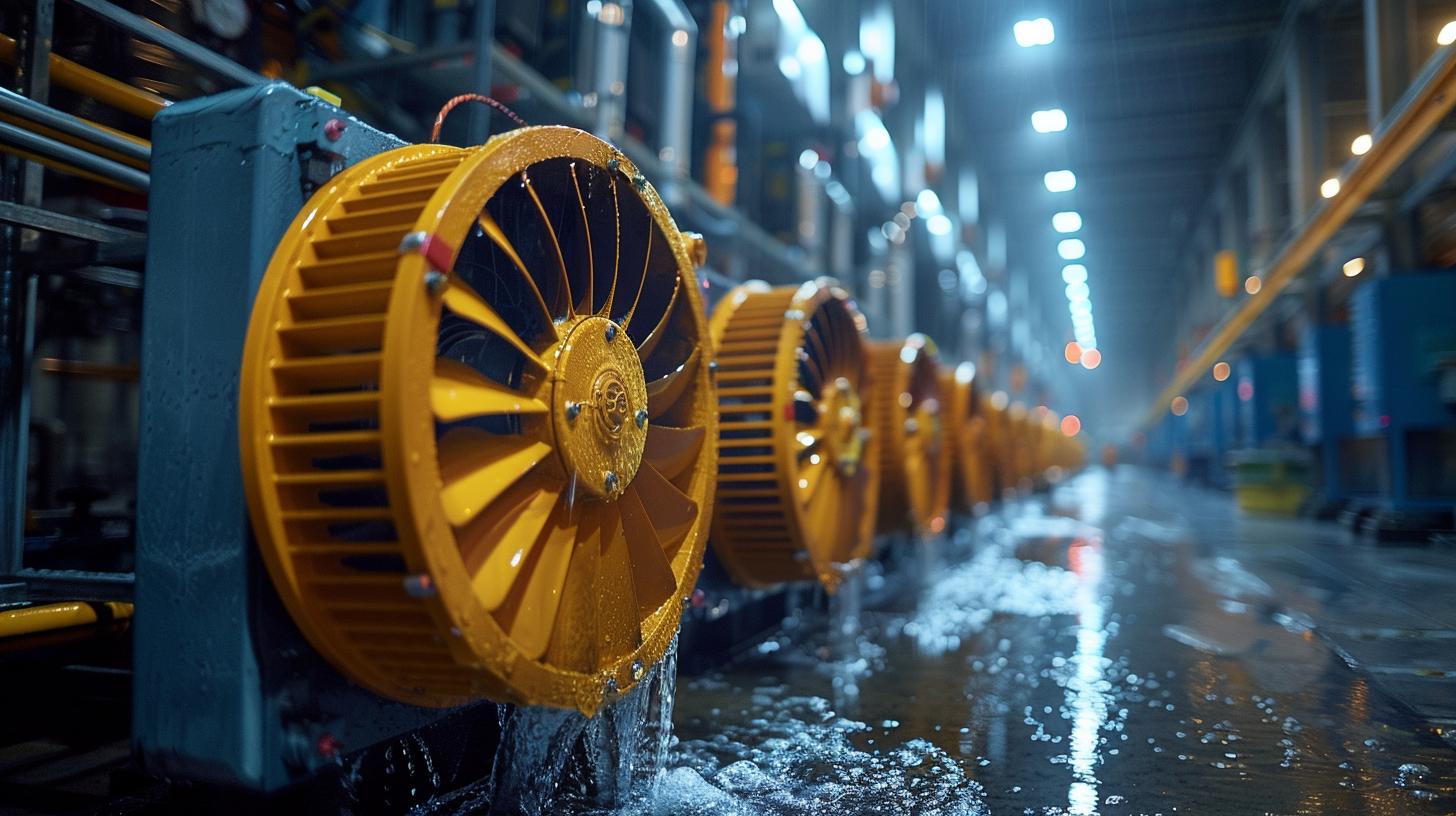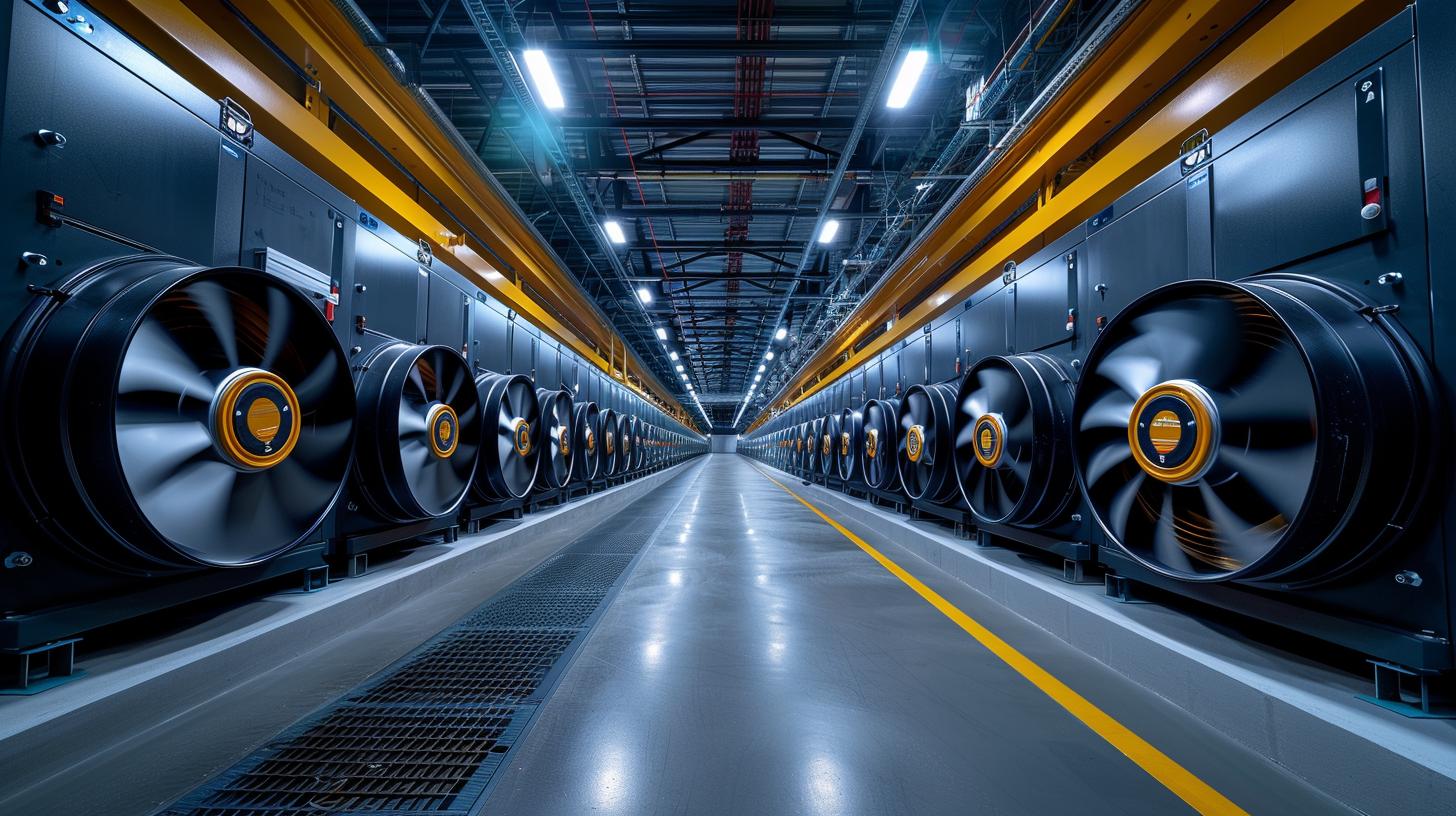Climate change poses a significant threat to numerous business sectors and industries-the world of cryptocurrency mining is no exception. The unwavering rise in global warming, extreme weather conditions, and environmental unpredictability has made it increasingly challenging for miners who largely depend on stable temperatures and conditions for optimal operations.
That’s where the concept of cryptocurrency climate resilient mining comes into play. Simply put, these are strategies that allow individuals or companies to continue their cryptocurrency mining activities without being negatively affected by adverse climate changes.
Cryptocurrency mining is an energy-intensive process that requires high computational power and consequently produces enormous heat. Without proper adjustment to the changing climates, overheating, reduced lifespan of equipment, loss of efficiency can occur – leading to decreased productivity or even total halting of mining operations. This makes addressing the effects of climate change on cryptocurrency mining not just an environmental concern but a critical business imperative as well.
To successfully adapt to such unpredictable circumstances, it is essential for businesses involved in cryptocurency mining to implement climate-resilient solutions. Climate Data AirFlow stands at the forefront of providing these solutions, specifically developed keeping in mind the fragile relationship between our changing environment and the demands of digital currency production.
By leveraging innovative technologies and techniques designed to optimize operations irrespective of external climate conditions, they ensure that crypto-mining does not become a casualty to global warming but instead transforms into a resilient industry capable thriving amidst environmental uncertainties. It is this transformation that represents a foundational shift towards a more durable future for cryptocurrency and its varied stakeholders.
Understanding the Intricacies of Cryptocurrency Mining Environment
The Environment of Cryptocurrency Mining
Cryptocurrency mining constitutes a detailed process that relies greatly upon computational power. “Miners,” or the computers undertaking the mining process, solve complex mathematical equations to validate digital transactions. Upon completion of these equations, transactions are bundled together in a ‘block’ and added to the blockchain, or the public ledger of all past transactions. The process is both functionality important for recording transactions and economically incentivised; cryptocurrency miners are rewarded with small amounts of cryptocurrency for each block they successfully mine.
However, an often overlooked detail in this process is how much energy cryptocurrency mining consumes. To put it into perspective, some estimates indicate that global Bitcoin mining activities consume more electricity annually than entire countries like Argentina or Ukraine do. This heavy power consumption generates excessive heat; hence, effective cooling solutions must be deployed continuously to prevent overheating which can result in expensive hardware degradation.
In locations where environmental temperatures are naturally high or fluctuate dramatically due to climate change, managing the inherent thermodynamic issues posed by cryptocurrency mining becomes increasingly challenging and resource demanding.
Cryptocurrency Mining Under Climate Change Constraints
As global climate patterns alter due to climate change, consistent natural conditions have become harder to predict or rely upon for maintaining optimal operating temperatures for cryptocurrency miners. High ambient temperatures force cooling mechanisms to work even harder, subsequently increasing overall power usage and compounding environmental footprint concerns.
Moreover, geographical regions characterized by particularly severe weather events such as hurricanes or wildfires expose operations to additional risk factors. Such situations necessitate risky shutdowns of systems – any sudden stoppages can lead to operational inefficiencies further down the line – therefore causing a dip in profitability.
To continue with regular operation while maintaining profitability amidst changing climates requires resilient solutions such as having access to alternate power sources during extreme weather events or deploying sophisticated cooling techniques capable of functioning under varied weather conditions; this ultimately introduces the concept of cryptocurrency climate resilient mining.

The Necessity for Climate Adaptable Solutions
Recognizing the innate challenges posed by climate change to cryptocurrency mining and understanding that the current realities make traditional strategies insufficient, it becomes imperative to seek adaptive solutions that simultaneously uphold operational efficiency and uphold environmental responsibility. These solutions often involve innovative hardware designs, advanced thermal management systems, and the ability to leverage renewable energy sources for both computation and cooling processes.
The need is not merely regulatory or altruistically driven; rather, given how power costs directly influence profitability in cryptocurrency mining, adopting greener options doubles as a business strategy – a trend that will increasingly dominate in the coming years. Implementation of these rigorous climate responsive principles decreases dependence on fossil fuel energy sources thereby reducing exposure to volatile energy prices which significantly impact the economic viability of mining operations.
Therefore, developing methods for effective cryptocurrency climate resilient mining has become an industry-wide prerogative.
Climate Data AirFlow’s Solutions
Optimizing Cryptocurrency Operations
Cryptocurrency mining is an energy-intensive process, and while climate conditions add to the challenges, Climate Data AirFlow offers a range of solutions designed to tackle these issues head-on. With their vast knowledge in environmental management and advanced technology, they offer cutting-edge solutions that prioritize efficiency and adaptability.
Climate Data AirFlow’s state-of-the-art systems adjust cryptocurrency operations according to varying environmental factors, ensuring continuous operation even under extreme climates. They have revolutionized the way mining setups work by incorporating climate-smart technology. Their systems detect changes in temperature, humidity, and other weather conditions and make automatic adjustments to keep the mining operations running smoothly.
This unique feature allows for efficient operation management without human intervention. From detecting over-heating processors under scorching temperatures to optimizing energy consumption during cold months, Climate Data AirFlow’s solutions are designed for every possible climate challenge.
Reduction in Energy Consumption
One of the key features of Climate Data AirFlow’s solutions is how they dramatically reduce energy consumption in cryptocurrency mining. Mining cryptocurrencies require a significant amount of electricity. In unfavorable weather conditions like extreme hot or cold temperatures, more energy would be necessary to keep equipment in optimal condition.
In contrast, by integrating smart technology into their systems capable of adapting real-time to changing weather conditions, Climate Data AirFlow has managed to significantly lower power usage while maintaining, if not improving overall performance regardless of external factors. The company’s unique focus on being climate resilient has made them leaders in green tech development within the cryptocurrency sector.
Cryptocurrency Climate Resilient Mining
The concept of cryptocurrency climate resilient mining revolves around developing systems that can withstand different climatic challenges without compromising performance or efficiency – precisely what Climate Data AirFlow’s solutions strive towards.
Their custom-tailored mining solutions incorporate intelligent system designs such as advanced cooling mechanisms that regulate temperature, smart algorithms to manage energy usage, and automation techniques for round-the-clock monitoring, not only making their technology versatile but also efficient. This has resulted in maintaining high operational capability regardless of the extreme external climate conditions.
By incorporating these climate resilient technologies into cryptocurrency mining operations, businesses can not only reduce costs but also limit their environmental impact, responding to a critical need in an era increasingly focused on sustainability.
Adapting to Extreme Environments With Climate Data AirFlow
Climate Data AirFlow offers innovative solutions to handle the potentially crippling effects of climate change on cryptocurrency mining. Utilizing a blend of cutting-edge technology and rigorous scientific analysis, their systems are designed to keep mining operations running even in the face of extreme environmental conditions. The bedrock of their strategy is a comprehensive approach that addresses each challenge individually while providing a cohesive solution.

One of Climate Data AirFlow’s key solutions is its smart cooling system. By using advanced sensors and algorithms, they can adjust the cooling systems in real-time based on ambient conditions, reducing power usage and minimizing unnecessary wear on equipment. Moreover, to manage the heat generated by cryptocurrency mining rigs more efficiently, Climate Data AirFlow designs customized heat distribution solutions for each site. This ensures optimal performance under a variety of climate conditions.
- Intelligent Climate Forecasting: Climate Data AirFlow uses machine learning algorithms to predict weather patterns accurately. It uses this data to adapt the operation parameters ahead of time – ensuring that changes in climate do not disrupt the ongoing mining process.
- Customized Design: Every setting is unique with its own set of challenges faced due to local climate variations. To tackle this, customizable infrastructure setups are offered that maximize efficiency depending on individual site’s microclimate.
- Energy-Efficient Cooling Tech: As higher temperatures adversely affect mining efficiency, effective cooling equipment forms an essential part of cryptocurrency climate resilient mining strategies developed by Climate Data AirFlow.
Furthermore, Climate Data AirFlow also emphasizes creating resilience through redundant systems designed for fail-safe operation in case any single component fails or conditions worsen beyond expected thresholds. In effect, by building robust environments that can weather harsh climatic shifts effectively maintaining consistent output despite exterior changes, these innovative measures enable miners to continue reaping profits without damaging our planet’s ecology. Thus embracing the notion of sustainable and profitable cryptocurrency mining.
Case Studies
Climate Data AirFlow’s solutions have already been successfully implemented in various cryptocurrency mining operations, underlining the practicality and effectiveness of these systems. These case studies highlight the measurable benefits of cryptocurrency climate resilient mining.
One noteworthy instance was a mining operation located in a region with severe seasonal changes, alternating between extreme heat in summer and intense cold in winter. Traditionally, such drastic shifts in conditions caused significant downtime, raising maintenance costs and reducing overall productivity.
Since implementing Climate Data AirFlow’s solutions, the company has reported more consistent operations across seasons. Their system is now able to adapt dynamically to both hot and cold weather without compromising its performance, directly contributing to an increase in profits.
Another notable example comes from a massive crypto-mining farm located near a coastal area known for unpredictable weather patterns including frequent storms and high humidity levels. These circumstances previously resulted in hardware damages due to moisture and power outages from storm-related interruptions.
Post-integration of Climate Data AirFlow’s systems, there was a remarkable decrease in weather-related disruptions. With the new system autonomously adjusting fan speed based on real-time meteorological data feeds, The mining operation has been able to minimize unforeseen weather impacts significantly reducing cost related hardware replacements.
Finally, firms operating within excessively dry desert environments have also enjoyed positive results. Before employing Climate Data AirFlow’s climate resilient technology, these firms grappled constantly with extreme temperatures that often resulted in machinery overheating despite intensive cooling measures. Following implementation of the AirFlow technologies which monitor minute-to-minute temperature fluctuations while optimizing the usage of cooling devices accordingly resulted notably increased efficiency, reducing expensive energy consumption substantially particularly during peak hours.
From operations struggling with severe season changes to those combating recurring humidity induced issues or dealing with soaring desert heat-the success cases demonstrate an intrinsic ability of Climate Data AirFlow’s solutions to help different mining operations adapt according to their local climatic challenges making their systems truly resilient regardless of their varied geographical situations ensuring successful continuity of their cryptocurrency mining operations.
Future Trends
The cryptocurrency mining landscape is rapidly changing due to the dual pressures of increasing demand for efficient operations and the unfolding crisis of climate change. The recognition of the need for cryptocurrency climate resilient mining solutions has been growing. Climate Data AirFlow’s cutting edge technology offers a way forward in this challenging context.

The adoption of technologies like Climate Data AirFlow not only makes existing operations more sustainable, but it also paves the way for future innovations in cryptocurrency mining. Specifically, these advancements provide:
- Increased efficiency: Cryptocurrency mining relies on high-performance computing resources which generate significant amounts of heat. Climate resilient solutions are designed to effectively manage this heat production, resulting in improved operational efficiency.
- Boosted resilience: As climate changes continue to intensify, extreme weather events, such as storms and severe heatwaves, are likely to become more frequent. Implementing these robust solutions helps ensure continuous operation even during extreme conditions.
- Mitigate environmental impact: Traditional methods of crypto mining are known for their hefty energy consumption, contributing significantly to environment degradation. However, adopting energy-efficient measures can drastically reduce the environmental impact.
Investments made today in these advanced technologies have a ripple effect that extends well into the future. They not only offer immediate benefits in managing existing challenges but allow operations flexibility to adapt and thrive under fluctuating environmental conditions.
Furthermore, as pressures mount from stakeholder groups including customers and regulatory bodies demanding clear steps towards sustainability, integrating environmentally-friendly strategies into business models could provide a competitive advantage.
Conclusion
In summary, the impacts of climate change on cryptocurrency mining are numerous and can hinder the sector’s sustainability if not adequately addressed. As we have discussed throughout this article, Climate Data AirFlow offers a promising solution to these challenges and plays an instrumental role in pushing the industry towards cryptocurrency climate resilient mining. Through their advanced technologies specifically designed for managing extreme environments, they cater to the nuances of cryptocurrency operations while minimizing energy consumption.
The outcomes presented in various case studies have demonstrated clearly the benefits of utilizing Climate Data AirFlow’s solutions. Not only do they enhance efficiency and maintain uninterrupted mining operations even amidst drastic climate changes, but there is also significant potential for cost savings by reducing energy usage. These features make it a practically compelling solution for entities involved in cryptocurrency mining.
Furthermore, adapting to the shifting climate conditions present will be paramount in ensuring the longevity and success of the crypto mining industry as a whole. The adoption of solutions such as those provided by Climate Data AirFlow is not just about surviving current conditions but strategically positioning oneself advantageously within this growing market sphere over the long term.
As we look ahead at future trends within this burgeoning industry, being resilient against climate change – with an emphasis on efficiency and sustainability – is likely to be not just preferred but vital. To dismiss these challenges coinciding with climate change would be ignoring a fundamental reality which can consequently lead to significant setbacks or limitations that inherently hinders growth opportunities.
Frequently Asked Questions
Is Crypto Mining Good for the Environment?
Crypto mining has a significant environmental impact due to its energy-intensive nature. It involves solving complex mathematic puzzles, which require substantial computational power and thus consume large amounts of electricity. The production process for this electricity often relies on fossil fuels, particularly coal, which leads to substantial carbon dioxide emissions. Therefore, crypto mining does pose challenges to the environment.
Which Crypto Is Climate Friendly?
Some cryptocurrencies are more climate-friendly than others. For example, Chia claims to have a more sustainable model by using a “proof of space and time” system rather than the traditional proof-of-work system used by Bitcoin. This approach aims to reduce energy consumption by utilizing hard drive space as opposed to computing power.
What Percent of Bitcoin Mining Is Renewable?
The use of renewable energy in Bitcoin mining varies widely due to factors such as the location of the miners and local energy policies. The Cambridge Centre for Alternative Finance estimated that approximately 39% of total Bitcoin mining is powered by renewable sources as of 2020.
Is Crypto Mining Still Feasible?
Crypto mining continues to be feasible somewhat depending on various factors such as electricity costs, hardware efficiency, and the market price of cryptocurrencies. However, it’s less accessible for individual miners because it requires high initial investment in hardware and continual consumption of electricity.
Hence, most modern crypto mining takes place in industrial-scale data centers that can operate more cost-effectively.
What Is the Carbon Footprint of Crypto Mining?
The carbon footprint of crypto mining primarily comes from its heavy reliance on electricity production processes often powered by greenhouse gas emitting fossil fuels like coal and natural gas.
A study published in the journal Nature found that Bitcoin operations alone emit over 22 million metric tons of carbon dioxide annually — approximately equal to the yearly emissions from Jordan or Sri Lanka.





